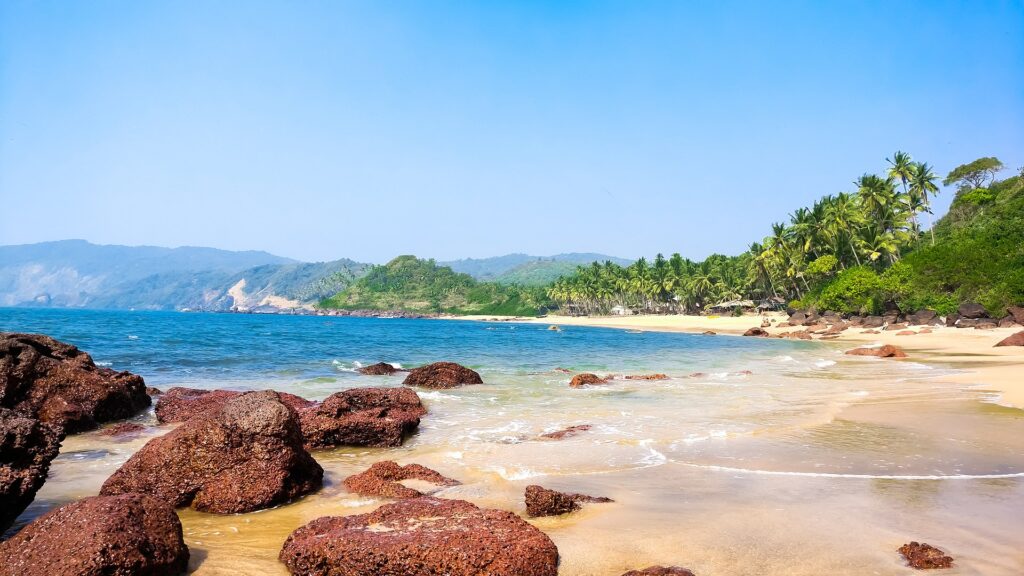
Image Source: Sam 8393
Goa, India’s smallest state by area, is a coastal paradise located on the western coast of India along the Arabian Sea. Known for its golden beaches, vibrant nightlife, Portuguese heritage, and laid-back lifestyle , Goa attracts millions of travelers from across the globe. It’s often referred to as the “Pearl of the Orient” and is celebrated for its unique blend of Indian and Portuguese cultures .
The capital city, Panaji (Panjim) is known for its Latin Quarter and colorful architecture, while Vasco da Gama and Margao reflect the state’s colonial past. Goa is divided into North Goa and South Goa—the former famous for its bustling beaches and parties, and the latter for its serenity and scenic beauty.
Geography of Goa
Goa lies between the Western Ghats on the east and the Arabian Sea on the west, making it a land blessed with natural beauty. The Mandovi and Zuari rivers are the lifelines of the state, forming picturesque estuaries and backwaters. The Western Ghats biodiversity hotspot extends into eastern Goa, featuring lush forests, spice plantations, and wildlife sanctuaries such as Bhagwan Mahavir Wildlife Sanctuary and Mollem National Park.
The coastline stretches about 105 km , dotted with palm-fringed beaches, cliffs, and hidden coves. The tropical climate ensures warm weather throughout the year, with the monsoon (June to September) transforming the region into a lush green paradise.
History of Goa
Goa’s history is as captivating as its landscape. It was once part of the Mauryan and Satavahana Empires , followed by the Kadambas and Chalukyas . However, Goa’s defining historical era began in 1510 AD , when Afonso de Albuquerque captured it for Portugal, marking the start of 450 years of Portuguese rule .
During this period, the region flourished as a global trade hub, exporting spices, cotton, and precious stones. The Portuguese influence shaped the local architecture, religion, cuisine, and language—visible even today in the Old Goa churches , Latin quarters , and colonial villas. Goa was liberated from Portuguese rule in 1961 and became India’s 25th state in 1987.
Culture of Goa
Goa’s culture is a harmonious blend of Hindu, Catholic, and tribal traditions . The Goan people, known as Goenkars , are warm, festive, and hospitable. The state celebrates both Indian and Western festivals with equal enthusiasm. Portuguese influence remains visible in music (Fado, Mando), architecture, and food.
Folk dances like Fugdi, Dhalo, Dekhni , and Kunbi showcase the local heritage, while the laid-back Goan lifestyle emphasizes the motto “Sossegado” —meaning a relaxed, content way of living.
Fairs & Festivals of Goa
Goa’s calendar is packed with colorful festivals that mirror its cultural diversity:
Goa Carnival – A pre-Lenten festival filled with music, parades, and masquerades in Panaji and Margao.
Feast of St. Francis Xavier – Celebrated at Basilica of Bom Jesus in Old Goa, drawing pilgrims worldwide.
Shigmo Festival – Goa’s version of Holi, celebrated with traditional dances and vibrant processions.
Sao Joao Festival – A monsoon festival where people leap into wells to celebrate St. John the Baptist.
Sunburn Festival – Asia’s biggest EDM festival held at Vagator Beach, attracting international artists.
Popular Dishes of Goa
Goan cuisine is a delicious fusion of Konkani and Portuguese flavors . Seafood dominates most meals, but the spice and aroma make every dish unforgettable.
Goan Fish Curry—A tangy, coconut-based curry with kingfish or pomfret.
Pork Vindaloo—Spicy Portuguese-origin dish made with vinegar and garlic.
Bebinca—A layered Goan dessert made with coconut milk and jaggery.
Xacuti—Rich curry made with roasted spices and grated coconut.
Prawn Balchão – Fiery pickle-style curry.
Feni & Urak—locally brewed cashew or coconut spirits unique to Goa.
Best Places to Visit in Goa
From iconic beaches to serene interiors, Goa offers a mix of everything:
Baga Beach & Calangute Beach—For water sports, cafes, and nightlife.
Anjuna & Vagator—Famous for flea markets and trance parties.
Old Goa – Home to UNESCO World Heritage churches like Basilica of Bom Jesus and Se Cathedral.
Dudhsagar Waterfalls—One of India’s tallest waterfalls, best seen by train or jeep safari.
Fontainhas, Panjim—Latin Quarter known for colorful Portuguese houses.
Palolem & Agonda—South Goa’s tranquil beaches perfect for relaxation.
Spice Plantations—Savoi and Ponda areas for aromatic tours.
Top Things to Do in Goa
A paradise for travelers, Goa offers endless experiences:
Beach Hopping—Explore North Goa’s lively beaches and South Goa’s secluded coves.
Scuba Diving & Snorkeling—Discover marine life at Grande Island.
River Cruise on Mandovi—Enjoy sunset views and Goan folk music.
Visit Fort Aguada & Chapora Fort—for stunning sea views and heritage exploration.
Try Water Sports—Jet skiing, parasailing, and banana rides.
Attend Night Markets – Like Anjuna and Arpora for souvenirs and street food.
Yoga & Wellness Retreats—Experience spiritual rejuvenation in Assagao or Canacona.
Offbeat Places to Visit in Goa
For those seeking lesser-known gems:
Divar Island—A quiet island village accessible by ferry from Old Goa.
Chorla Ghats – Misty mountain passes perfect for treks and nature walks.
Tambdi Surla Temple—A 12th-century Kadamba-style temple deep in the forest.
Arvalem Caves & Waterfall – Ancient rock-cut caves with Buddhist origins.
Netravali Wildlife Sanctuary—Hidden forest reserve with bubbling lakes.
Souvenirs to Buy from Goa
Take home a bit of Goa’s spirit with:
Cashew nuts and Feni bottles
Shell and bamboo crafts
Azulejos (Portuguese-style ceramic tiles)
Goan masalas and coconut oil
Hand-painted magnets and beachwear
Best Time to Visit Goa
Winter (November–February): Pleasant weather, ideal for beaches, parties, and sightseeing.
Monsoon (June–September): Perfect for nature lovers, waterfalls, and spice plantation tours.
Summer (March–May): Hot but less crowded, great for budget travelers.
How to Reach Goa
By Air: Goa International Airport (Dabolim) and the new Mopa Airport (North Goa) connect with major Indian and international cities.
By Train: Madgaon (Margao) and Thivim are the main railway stations.
By Road: Well-connected by NH 66 and NH 748 to Mumbai, Pune, and Mangalore.
By Sea: Luxury cruises now operate between Mumbai and Goa, offering a scenic journey.
Why Visit Goa—What Makes It Unique
Goa is not just a destination—it’s a feeling. From sun-drenched beaches and lush hills to colonial architecture and carefree vibes , Goa captures the essence of tropical bliss. It’s a place where East meets West , where Fado music echoes with temple bells , and where every sunset invites you to slow down and embrace life the Goan way—“Sossegado.”
